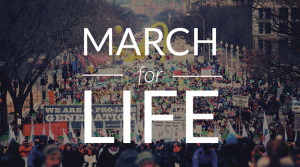About ten years ago I was in my then-supervisor’s office at a government agency. It was the afternoon of January 22, and he was staring out the window at streams of warm-coated placard-toting Marchers heading back towards Union Station following another March for Life. “I hate January 22,” he remarked, “I always feel like I should be out there instead of in here.”
My boss was a fellow Catholic and an occasional daily Mass goer at St. Joe’s on Capitol Hill – where, on holy days of obligation, you could occasionally see Ted Kennedy and where, when the Supreme Court is in session, you can often see Justice Clarence Thomas. Although my boss’s politics tracked somewhat closer to Ted’s than to Justice Thomas’s, he was a decent man. And he reacted as decent D.C. residents and employees generally do to January 22, when it becomes much more difficult than usual to block out what January 22, 1973, did to America.
When you live or work in Washington D.C., unless you’re employed in the Supreme Court or the Capitol building, it is quite easy to avoid the actual March, which takes place in a quite localized, several-block area that most of the agencies and enterprises of the city do not overlook. But it is impossible to avoid the Marchers, particularly the very large number of youthful ones, who begin descending on the city a few days before and travel in large high-spirited crowds.
Many of them are part of high school or college groups. Those who need to stay at least one night somewhere often bunk down in church, Catholic school basements, and the like. The locals encounter them piling into Metro cars on the day of the March with excited laughter and chatter, and the signs, of course. Those on their way to work cast them sidelong glances and then look away. Very early on the morning of January 22, many of the Marchers can be found satisfying healthy young appetites in the food court on the lower level of Union Station; government workers walk around them as they pause to pick up coffee on the way to the office. But they cannot really ignore them: The Marchers are young, exuberant, and legion; they are hard to miss.
That is important to keep in mind, especially when people bemoan (as they should) the often-poor or slanted media coverage of the event. It somewhat diminishes, of course, the effect of the March – and is intended to do so. For better or worse, in addition to the lowly worker bees in our nation’s capital, some pretty important movers and shakers (both well-known and behind the scenes) spend their days here. That, after all, is why Marchers began coming to D.C., beginning in 1974, one year after Roe v. Wade legalized abortion. I myself was very young at the time of Roe, just short of 17.
I’ve spent many decades, most of a lifetime, living in a country with legalized abortion. And these children, these successful survivors of the womb, have spent all of theirs in a country officially indifferent to their safe transit down the birth canal. It bothers them, as it should, and it is good to let them more deeply bother the folks who live and work here, many of whom, despite who they vote for or work for or what they think they believe, don’t really feel good when they think about abortion.
These thoughts were in my mind at Mass at St. Joe’s this week, where a large group of students from Kalamazoo, MI (Kalamazoo! Bless their hearts!) were in attendance. The first reading told the story of David’s encounter with Goliath. David was “youthful, and ruddy, and handsome in appearance.” But “the Philistine held David in contempt.” No matter, though. David knew that, “All this multitude, too, shall learn that it is not by sword or spear that the Lord saves. For the battle is the Lord’s, and he shall deliver you into our hands.”
That’s the kind of optimistic thinking that hanging around a group of young people will induce. Not that I expect Planned Parenthood or the Democrats in Congress or the recalcitrant majority of the Supreme Court justices to be toppled by these young Marchers – not yet, anyway, not even after the year of surprises we’ve had. Still, someday it will happen.
The Marchers – whether young, middle-aged, or old – in sheer numbers, goodness of intentions, justice of their cause, and the blessed commonsense of their matter-of-fact recognition that life is good, incarnate a great truth in a form it takes an effort to ignore.
That truth is that it is good to be alive. It is objectively good; human life is an objective good that doesn’t depend on whether our circumstances are desperate or demoralizing or our mood suicidal; whether we are alone or in pain. God has created us, and that creation, however we feel about it at the moment (“I didn’t ask to be alive!”), it is a good thing.
Those of a certain age and burdened with certain life experiences know the bittersweet feeling that can fall on you during a couple’s wedding, even the wedding of good and devoutly Catholic young people. You are so aware of what the young couple doesn’t know – of what no one can know at the time: A child’s heartbreaking handicap or addiction, a husband’s unemployment, grave illness, and on and on and on. The young couple and their friends theoretically know these things too, but their feelings are generally different. They are hope-filled, trusting each other, and trusting God, trusting life.
Now, whose feelings better reflect the reality of what is happening? Whose feelings should be acted upon? Each year on January 22, those of us in D. C. – and many elsewhere – are confronted by the reality: life is good.















